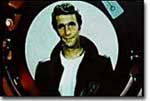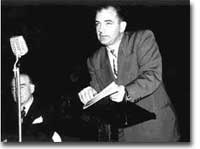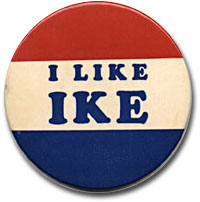
53. The 1950s: Happy Days

It didn't start airing until 1974, but the television show Happy Days portrayed the carefree '50s through the antics of characters named Potsie, Chachi, and Fonzie (above).
Show everybody what I've found
Rock-'n'-roll with all my friends
Hopin' the music never ends.
These happy days are yours and mine.
-Happy Days, theme song
In American memory, the postwar 1950s have acquired an idyllic luster. Reruns of 1950s TV shows such as Leave It to Beaver and Father Knows Best leave today's viewers with an impression of unadulterated family bliss. The baby boomers look back nostalgically to these years that marked their early childhood experiences.

The actions of Senator Joseph McCarthy tarnished the relaxed attitude of the 1950s. His hunt for communists working in the U.S. showcased the paranoia and fear that gripped America.
The president for many of these years was war hero Dwight Eisenhower. Ike, as he was nicknamed, walked a middle road between the two major parties. This strategy, called Modern Republicanism, simultaneously restrained Democrats from expanding the New Deal while stopping conservative Republicans from reversing popular programs such as Social Security. As a result, no major reform initiatives emerged from a decade many would describe as politically dead. Perhaps freedom from controversy was the prize most American voters were seeking after World War II and the Korean War.
Living in a Material World

Dwight D. "Ike" Eisenhower's campaign slogan "I Like Ike" epitomized the swell spirit that defined American culture in the 1950s.
A booming economy helped shape the blissful retrospective view of the 1950s. A rebuilding Europe was hungry for American goods, fueling the consumer-oriented sector of the American economy. Conveniences that had been toys for the upper classes such as fancy refrigerators, range-top ovens, convertible automobiles, and televisions became middle-class staples.
The pent-up demand for consumer goods unleashed after the Great Depression and World War II sustained itself through the 1950s. Homes became affordable to many apartment dwellers for the first time. Consequently, the population of the suburbs exploded. The huge youth market had a music all of its own called rock and roll, complete with parent-detested icons such as Elvis Presley.
Happy Days — But Not for All
Of course, not everything was as rosy as it seemed. Beneath the pristine exterior, a small group of critics and nonconformists pointed out the flaws in a suburbia they believed had no soul, a government they believed was growing dangerously powerful, and a lifestyle they believed was fundamentally repressed. And much of America was still segregated.
Nevertheless, the notion of the 1950s as happy days lived on. Perhaps when measured against the Great Depression of the 1930s, the world war of the 1940s, the strife of the 1960s, and the malaise of the 1970s, the 1950s were indeed fabulous.





